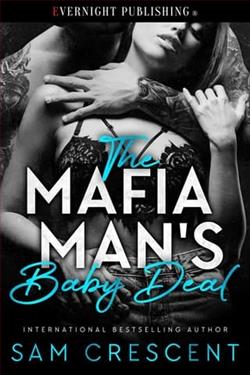Page 11 of A Son of the Circus
In the doctor’s view, her behavior was shameless for a married, middle-aged lady—Dr. Daruwalla calculated that she was in her early fifties. Yet Farrokh found the second Mrs. Dogar attractive, in a threatening kind of way. He couldn’t locate exactly what it was that attracted him to the woman, whose arms were long and unflatteringly muscular, and whose lean, hard face was handsome and challenging in an almost masculine way. To be sure, her bosom was shapely (if not full) and her bottom was high and firm—especially for a woman her age—and there was no question that her long waist and aforementioned navel were enhancing contributions to the pleasurable impression she made in a sari. But she was too tall, her shoulders were too pronounced and her hands appeared absurdly large and restless; she picked up her silverware and toyed with it as if she were a bored child.
Furthermore, Farrokh had caught a glimpse of Mrs. Dogar’s feet—actually, just one of her feet, which was bare. She must have kicked her shoes off under her table, but all that Dr. Daruwalla saw was a flash of her gnarled foot; a thin gold chain hung loosely around her surprisingly thick ankle and a wide gold ring gripped one of her clawlike toes.
Perhaps what attracted the doctor to Mrs. Dogar was how she reminded him of someone else, but he couldn’t think of who it might be. A long-ago movie star, he suspected. Then, as a doctor whose patients were children, he realized that he might have known the new Mrs. Dogar as a child; why this would make the woman attractive to him was yet another, exasperating unknown. Moreover, the second Mrs. Dogar seemed not more than six or seven years younger than Dr. Daruwalla; virtually, they’d been children together.
Dhar caught the doctor by surprise when he said, “If you could see yourself looking at that woman, Farrokh, I think you’d be embarrassed.” When he was embarrassed, the doctor had an annoying habit of abruptly changing the subject.
“And you! You should have seen yourself!” Dr. Daruwalla said to Inspector Dhar. “You looked like a bloody police inspector—I mean, you looked like the real bloody thing!”
It irritated Dhar when Dr. Daruwalla spoke such absurdly unnatural English; it wasn’t even the English with a singsong Hindi lilt, which was also unnatural for Dr. Daruwalla. This was worse; it was something wholly fake—the affected British flavor of that particularly Indian English, the inflections of which were common among young college graduates working as food-and-beverage consultants at the Taj, or as production managers for Britannia Biscuits. Dhar knew that this unsuitable accent was Farrokh’s self-consciousness talking—he was so out of it in Bombay.
Quietly, but in accentless English, Inspector Dhar spoke to his excited companion. “Which rumor about me are we encouraging today? Should I shout at you in Hindi? Or is this a good day for English as a second language?”
Dhar’s sardonic tone and expression hurt Dr. Daruwalla, notwithstanding that these mannerisms were trademarks of the fictional character Dr. Daruwalla had created and that all of Bombay had come to loathe. Although the secret screenwriter had grown morally uncertain of his creation, this doubt was not discernible in the unreserved fondness that the doctor felt for the younger man; in public or in private, it was Dr. Daruwalla’s love for Dhar that showed.
The taunting quality of Dhar’s remarks, not to mention the sting of Dhar’s delivery, wounded Dr. Daruwalla; even so, he regarded the slightly spoiled handsomeness of the actor with great tenderness. Dhar allowed his sneer to soften into a smile. With an affection that alarmed the nearest and ever-observant waiter—the same poor fellow whose daily course had coincided with the shitting crow and with the troublesome tureen and ladle—the doctor reached out and clasped the younger man’s hand.
In plain English, Dr. Daruwalla whispered, “I’m really just so sorry—I mean, I feel so sorry for you, my dear boy,” he said.
“Don’t,” Inspector Dhar whispered back. His smile faded and his sneer returned; he freed his hand from the elder man’s grip.
Tell him now! Dr. Daruwalla told himself, but he didn’t dare—he didn’t know where to begin.
They were sitting quietly with their tea and some sweets when the real policeman approached their table. They’d already been interrogated by the duty officer from the Tardeo Police Station, an Inspector Somebody—not very impressive. The inspector had arrived with a team of subinspectors and constables in two Jeeps—hardly necessary for a golfing death, Dr. Daruwalla had felt. The Tardeo inspector had been unctuous but condescending to Inspector Dhar and servile to Farrokh.
“I am hoping you are excusing me, Doctor,” the duty officer had begun; his English was a strain. “I am being most sorry I am taking your time, saar,” the inspector added to Inspector Dhar. Dhar responded in Hindi.
“You are not examining the body, Doctor?” the policeman asked; he persisted with his English.
“Certainly not,” Dr. Daruwalla replied.
“You are never touching the body, saar?” the duty officer asked the famous actor.
“I are never touching it,” Dhar answered in English—in a flawless imitation of the policeman’s Hindi accent.
Upon departing, the duty officer’s heavy brogues had scraped a little too loudly on the stone floor of the Duckworth Club’s dining room; thus had the policeman’s exit drawn Mr. Sethna’s predictable disapproval. Doubtless the old steward had also disapproved of the condition of the duty officer’s uniform; his khaki shirt was soiled by the thali the inspector must have encountered for lunch—a generous portion of dhal was slopped on his breast pocket, and a brightly colored stain (the obvious orange-yellow of turmeric) lit up the messy policeman’s drab collar.
But the second policeman, who now approached their table in the Ladies’ Garden, was no mere inspector; this man was of a higher rank—and of a noticeably elevated neatness. At the very least, he looked like a deputy commissioner. From Farrokh’s research—for the Inspector Dhar screenplays were scrupulously researched, if not aesthetically pleasing—the screenwriter was certain that they were about to be confronted by a deputy commissioner from Crime Branch Headquarters at Crawford Market.
“All this for golf?” whispered Inspector Dhar, but not so loudly that the approaching detective could hear him.
Not a Wise Choice of People to Offend
As the most recent Inspector Dhar movie had pointed out, the official salary of a Bombay police inspector is only 2,500 to 3,000 rupees a month—roughly 100 dollars. In order to secure a more lucrative posting, in an area of heavy crime, an inspector would need to bribe an administrative officer. For a payment in the vicinity of 75,000 to 200,000 rupees (but generally for less than 7,000 dollars), an inspector might secure a posting that would earn him from 300,000 to 400,000 rupees a year (usually not more than 15,000 dollars). One issue posed by the new Inspector Dhar movie concerned just how an inspector making only 3,000 rupees a month could get his hands on the 100,000 rupees that were necessary for the bribe. In the movie, an especially hypocritical and corrupt police inspector accomplishes this by doubling as a pimp and a landlord for a eunuch-transvestite brothel on Falkland Road.
In the pinched smile of the second policeman who approached Dr. Daruwalla and Inspector Dhar at their table, there could
be discerned the unanimous outrage of the Bombay police force. The prostitute community was no less offended; the prostitutes had greater cause for anger. The most recent movie, Inspector Dhar and the Cage-Girl Killer, seemed to be responsible for putting the lowliest of Bombay’s prostitutes—the so-called cage girls—in particular peril. Because of the movie, about a serial killer who murders cage girls and draws an inappropriately mirthful elephant on their naked bellies, a real murderer appeared to have stolen the idea. Now real prostitutes were being killed and decorated in this cartoonish fashion; the actual murders were unsolved. In the red-light district, on Falkland Road and Grant Road—and throughout the multitude of brothels in the many lanes of Kamathipura—the hardworking whores had expressed a real desire to kill Inspector Dhar.
The feeling for vengeance toward Dhar was especially strong among the eunuch-transvestite prostitutes. In the movie, a eunuch-transvestite prostitute turns out to be the serial cartoonist and killer. This was offensive to eunuch-transvestites, for by no means were all of them prostitutes—nor were they ever known to be serial killers. They are an accepted third gender in India; they are called “hijras”—an Urdu word of masculine gender meaning “hermaphrodite.” But hijras are not born hermaphrodites; they are emasculated—hence “eunuch” is the truer word for them. They are also a cult; devotees of the Mother Goddess Bahuchara Mata, they achieve their powers—either to bless or to curse—by being neither male nor female. Traditionally, hijras earn their living by begging; they also perform songs and dances at weddings and festivals—most of all, they give their blessings at births (of male infants, especially). And hijras dress as women—hence the term “eunuch-transvestite” comes closest to what they are.
The mannerisms of hijras are ultra-feminine but coarse; they flirt outrageously, and they display themselves with sexually overt gestures—inappropriate for women in India. Beyond their castration and their female dress, they do little to otherwise feminize themselves; most hijras eschew the use of estrogens, and some of them pluck their facial hair so indifferently, it’s not uncommon to see them with several days’ growth of beard. Should hijras find themselves abused or harassed, or should they encounter those Indians who’ve been seduced by Western values and who therefore don’t believe in the hijras’ “sacred” powers to bless and curse, hijras will be so bold as to lift their dresses and rudely expose their mutilated genitals.
Dr. Daruwalla, in creating his screenplay for Inspector Dhar and the Cage-Girl Killer, never intended to offend the hijras—there are more than 5,000 in Bombay alone. But, as a surgeon, Farrokh found their method of emasculation truly barbarous. Both castration and sex-change operations are illegal in India, but a hijra’s “operation”—they use the English word—is performed by other hijras. The patient stares at a portrait of the Mother Goddess Bahuchara Mata; he is advised to bite his own hair, for there’s no anesthetic, although the patient is sedated with alcohol or opium. The surgeon (who is not a surgeon) ties a string around the penis and the testicles in order to get a clean cut—for it is with one cut that both the testicles and the penis are removed. The patient is allowed to bleed freely; it’s believed that maleness is a kind of poison, purged by bleeding. No stitches are made; the large, raw area is cauterized with hot oil. As the wound begins to heal, the urethra is kept open by repeated probing. The resultant puckered scar resembles a vagina.
Hijras are no mere cross-dressers; their contempt for simple transvestites (whose male parts are intact) is profound. These fake hijras are called “zenanas.” Every world has its hierarchy. Within the prostitute community, hijras command a higher price than real women, but it was unclear to Dr. Daruwalla why this was so. There was considerable debate as to whether hijra prostitutes were homosexuals, although it was certain that many of their male customers used them in that way; and among hijra teenagers, even before their emasculation, studies indicated frequent homosexual activity. But Farrokh suspected that many Indian men favored the hijra prostitutes because the hijras were more like women than women; they were certainly bolder than any Indian woman—and with their almost-a-vagina, who knew what they could imitate?
If hijras themselves were homosexually oriented, why would they emasculate themselves? It seemed probable to the doctor that, although there were many customers in the hijra brothels who were homosexuals, not every customer went there for anal intercourse. Whatever one thought or said about hijras, they were a third gender—they were simply (or not so simply) another sex. What was also true was that, in Bombay, fewer and fewer hijras were able to support themselves by conferring blessings or by begging; more and more of them were becoming prostitutes.















